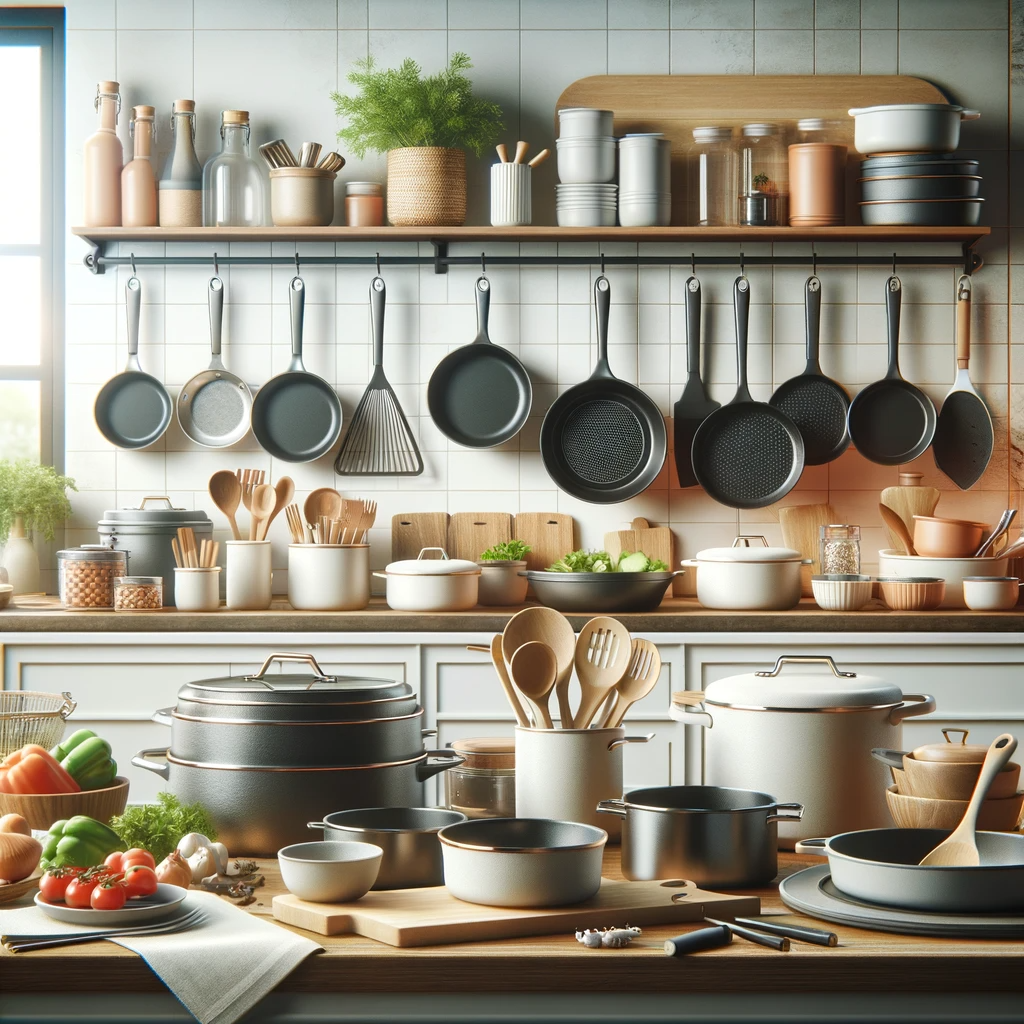
Understanding Why Non-Toxic Cookware is Essential for Promoting a Healthy Kitchen Environment
Share
The kitchen, from where our nourishment comes, must also be a place of safety and wellness. An essential yet often overlooked aspect of this is the importance of non-toxic cookware. Using non-toxic pots, pans, and utensils in the kitchen can significantly reduce the risk of exposure to harmful chemicals that can leach into food during cooking.
The Dangers of Toxic Cookware
Most conventional cookware materials include dangerous compounds like perfluorooctanoic acid (PFOA), used in non-stick coatings, lead in ceramic glazes, or aluminum. These are all substances that have been linked to serious health issues like cancer, liver damage, and neurological problems.
- PFOA:When overheated, non-stick cookware can release fumes containing PFOA. Studies have linked PFOA exposure to kidney and testicular cancer, thyroid disease, and hypertension during pregnancy.
- Lead:Some ceramic glazes contain lead which can leach into food during cooking. Chronic lead exposure can lead to neurological issues and developmental delays in children.
- Aluminum:While aluminum cookware is lightweight and heats up quickly, it may also leach into food during cooking. High levels of aluminum intake have been associated with neurological effects like changes in mental behavior.
Benefits of Non-Toxic Cookware
Switching to non-toxic cookware not only minimizes your exposure to these harmful substances but also offers several other benefits:
- Durability:Most non-toxic cookware options are very durable and long-lasting compared to their toxic counterparts.
- Heat Distribution:Materials like cast iron evenly distribute heat for better cooking results.
- Easy Maintenance:Many non-toxic options (like stainless steel) are easy to clean and maintain.
Choosing Non-Toxic Cookware
When shopping for non-toxic cookware, look for materials like stainless steel, cast iron, and glass. Be sure to research the brand and product thoroughly before making a purchase.
- Stainless Steel:It is known for its ability to resist corrosion and rust, making it an excellent choice for cookware.
- Cast Iron:Cast iron pans are durable, cheap, and if cared for properly can last for generations.
- Glass:Glass bakeware is non-reactive, which means it will not release any substances into food while cooking.
To create a healthy kitchen environment, we must consider every detail – including the tools we use to prepare our meals. Non-toxic cookware is a simple change that can have a significant impact on our health in the long run.
In the bustling rhythm of modern life, it’s often tempting to resort to fast food or pre-cooked meals. Yet, embracing home cooking can provide numerous health benefits that you might not be aware of. This article delves into seven surprising health benefits associated with preparing meals at home.
1. Enhanced Nutritional ConsumptionWhen you cook at home, you have control over your ingredients and can ensure that your meals are packed with beneficial nutrients. You can include more fresh fruits, vegetables, and whole grains into your dishes to augment your daily nurtition intake.
2. Portion ControlRestaurants often serve oversized portions, which contributes to overeating and possible weight gain. Home cooking allows you to control portion sizes and prevent excessive calorie consumption.
3. Reduced Intake of Processed FoodsFast food and processed foods tend to be high in sodium, unhealthy fats, and added sugars. By cooking at home, you can avoid these harmful ingredients and use healthier alternatives.
4. Food Allergy ManagementFor individuals with food allergies or dietary restrictions, eating out can pose a challenge. Cooking at home eliminates this risk as it provides the flexibility to customize recipes based on individual dietary needs.
5. Promotes Healthy HabitsCooking at home encourages healthier eating patterns such as mindful eating – paying attention to what’s on your plate and enjoying each bite fully – which is linked with weight management and improved wellbeing.
6. Saves MoneyWhile not directly a health benefit, saving money by cooking at home can reduce financial stress – a common cause of health issues like anxiety and sleep disorders.
7. Therapeutic BenefitsMany people find the process of preparing a meal relaxing and therapeutic – a form of ‘culinary therapy’. The physical act of preparing ingredients and cooking a meal can act as a stress reliever.
While cooking at home may require time and effort, the numerous health benefits it offers make it a worthwhile investment. By enabling control over ingredients, portion size, and pacing of meals, home cooking not only ensures healthier eating but also promotes a more mindful approach towards food. Furthermore, the indirect benefits such as cost savings and therapeutic effects contribute to overall physical and mental wellbeing. So, consider dusting off your pots and pans and reignite that stove – your body will thank you for it!
Carbon offsets have been heralded by some as a solution to the pressing issue of climate change. However, others argue that they serve only as a form of greenwashing. It is necessary to thoroughly understand what carbon offsets are and how they work before determining their efficacy as a climate solution.
In essence, by purchasing carbon offsets, an individual or business is paying others to reduce their CO2 output or remove existing CO2 from the atmosphere.
However, not all carbon offsets are created equal.
- Emissions Reduction:These involve projects that directly reduce the amount of greenhouse gas emissions, such as renewable energy initiatives like wind farms and solar power installations.
- Carbon Sequestration:These involve projects focused on absorbing and storing carbon dioxide already in the atmosphere, such as reforestation and soil management efforts.
While these initiatives sound promising on paper, it’s crucial to examine their effectiveness critically. Critics argue that some companies use carbon offsets as an excuse not to reduce their own emissions directly – hence the term ‘greenwashing.
Moreover, concerns about verification and permanence often surround sequestration projects like reforestation. Verifying the actual amount of CO2 absorbed is a complex process subject to many uncertainties. Additionally, there’s no guarantee that these forests won’t be destroyed in future fires or logging activities, which would release any sequestered CO2 back into the atmosphere.
On the other hand, proponents argue that properly managed offset projects do indeed contribute significantly towards mitigating climate change effects. They point out that renewable energy projects not only cut down on current carbon emissions but also establish infrastructure for future low-carbon societies.
Besides, some argue that carbon offsetting, while not a perfect solution, provides an immediate response to climate change while longer-term solutions are being developed and implemented.
In the end, it seems the answer to whether carbon offsets are greenwashing or a genuine climate solution is not black and white. The effectiveness of carbon offsetting largely depends on the type and quality of the project, rigorous monitoring and verification methods, and whether it is used in conjunction with direct emission reduction strategies.
It remains vital for businesses and individuals to prioritize reducing their own carbon emissions first and foremost. Carbon offsets should be viewed as part of a broader climate strategy rather than a one-stop solution. Increasing transparency, stricter regulation of offset projects, and public accountability can help ensure that carbon offsets contribute meaningfully to global climate change mitigation efforts.
Exploring the Best Alternatives to Disposable Plastic Straws: A Comprehensive Ranking
In recent years, environmental concerns have sparked a global conversation about the importance of reducing our dependence on single-use plastics. Leading the charge is the movement to eliminate disposable plastic straws. These small items contribute to plastic pollution and are not easily recycled due to their size and weight. In response, several alternatives have emerged on the market.
Bamboo Straws
Bamboo straws provide a biodegradable solution that also adds a unique aesthetic appeal to your drink.
- Pros: Biodegradable, often handmade promoting local economies
- Cons: Limited lifespan compared to metal or glass, can alter taste slightly
Stainless Steel Straws
Stainless steel straws are one of the most popular alternatives. They are durable, reusable, and rustproof. Most stainless steel straws come with a cleaning brush and a storage bag for easy cleaning and portability.
- Pros: Durable, long-lasting, easy to clean
- Cons: Can alter beverage temperature (hot or cold), not ideal for children due to rigidity
Glass Straws
Glass straws offer an aesthetically pleasing alternative with their sleek design. They are reusable and often dishwasher-safe.
- Pros: See-through material makes it easy to check cleanliness, does not change drink’s taste
- Cons: Fragile nature can lead to breakages
Paper Straws
Paper straws were among the first alternatives suggested for plastic straws but they have been met with mixed reception due to durability issues.
- Pros: Biodegradable and compostable
- Cons: Can become soggy quickly, altering texture and drinking experience
Silicone Straws
Silicone straws offer flexibility that metal or glass alternatives cannot offer making them safe for children.
- Pros: Soft material prevents injury, does not alter beverage temperature
- Cons: More challenging to clean, may not be as durable
Edible Straws
Edible straws are a fun and innovative option. Made from various food products like seaweed or pasta, they can be consumed after use.
- Pros: Eliminates waste completely, can enhance drink flavour
- Cons: Limited availability, potential for allergy issues
No Straw At All
The most sustainable option might be opting for no straw at all wherever possible.
In terms of ranking, stainless steel and glass straws might take the lead due to their durability and reusability. However, the best alternative truly depends on individual needs and preferences. Remember, the goal is to reduce single-use plastic consumption, and even small changes like choosing an alternative straw can contribute significantly in the long run.
Cookware can significantly impact your cooking and overall health. Using safe cookware can ensure that your meals are not only delicious, but also free from harmful substances. Below are some of the safest cookware options for your home.
Cast Iron
Cast iron has been used as a cooking material for hundreds of years. They’re known for their durability and excellent heat retention. The main advantage of cast iron is that it doesn’t release toxic fumes, even under high heat. Plus, it offers a natural way to increase the iron content in our food.
Stainless Steel
Stainless steel is another safe option for cookware. It’s resistant to damage and does not corrode or wear away easily, meaning it won’t leak any harmful substances into your food. High quality stainless steel with an alloy mixture of steel, carbon, and chromium provides long-lasting kitchen equipment that is safe for cooking.
Ceramic
Ceramic is one of the safest materials used in cookware production today, as it’s made purely from sand and water. It does not contain any metals or toxic chemicals, and therefore does not leach any harmful substances into food while cooking.
Glass
Glass provides an entirely non-reactive environment which means it does not absorb odors or colors, nor does it react with food while cooking. Glass pots are perfect for boiling and steaming but they cannot be used in direct heat like stove tops.
Copper Pots with Stainless Steel Lining
Copper pots lined with stainless steel unite the excellent heat conductivity of copper with the low-reactivity of stainless steel lining. This means you get faster cooking times without having to worry about copper leaching into your meals.
It’s important to avoid cookware made from harmful materials such as aluminum and non-stick Teflon (also known as PTFE). These materials can leach into your food and are linked to various health problems.
- Opt for cookware with a flat bottom – they heat more evenly and thus reduce cooking time and energy consumption.
- Pay attention to the weight – heavy pots usually have better heat absorption and distribution.
- Consider maintenance – some materials require more care than others. For instance, cast iron needs seasoning from time to time.
Choosing the right cookware is key not only for preparing delicious meals, but also for ensuring a healthy lifestyle. So take a moment to ponder upon these safe cookware options before making your next purchase!
